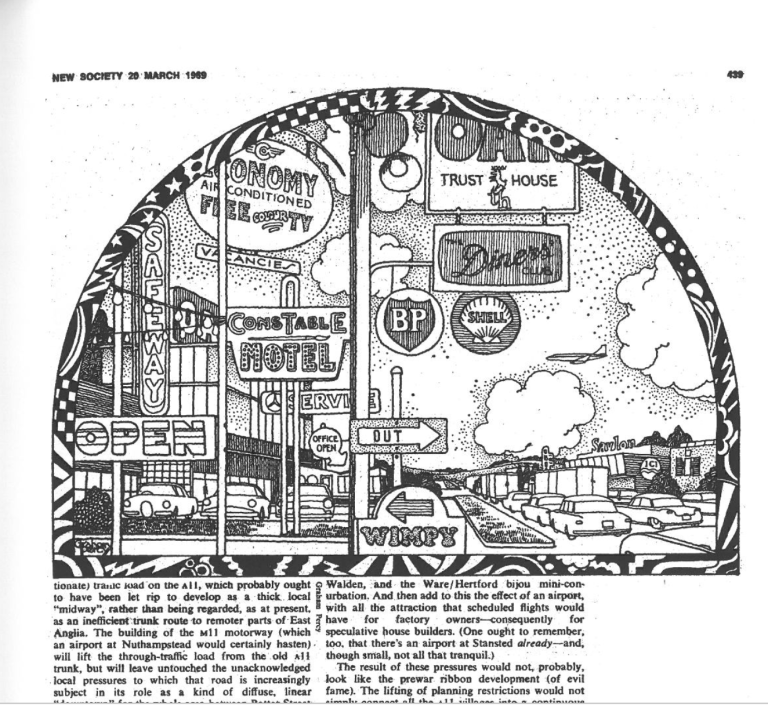The somewhat accidental grandfather of Canary Wharf was a man called Peter Hall, who shouldn’t be confused with all the other Peter Halls. This Peter Hall was an academic, the big man in the study of urban planning. Hall enjoyed dabbling in unorthodox, speculative thinking – he was the kind of chap who, if somewhat said, ‘Well, obviously, that’s the way it’s done,’ would keep asking, ‘Yes, but why?’ So as a man who had dedicated his life to the looking at the way cities are planned and can be planned, the most famous thing he ever worked on was called Non-Plan, which excitedly wondered what would happened if you got rid of planning altogether.
Subtitled ‘An experiment in freedom’, Non-Plan was written by Hall along with the (extraordinary) architecture critic/academic Reyner Banham, journalist Paul Barker and architect Cedric Price and published in 1969 in New Society magazine. The writers had a Pop Arty passion for the US of the 1950s and ’60s – here’s Banham’s unironically titled documentary Reyner Banham Loves Los Angeles. They were pro-suburbia, pro-strip malls, pro-neon signs…

© New Society, 1969
I think it’s fair to say that there was a sizeable element of wind-up in Non-Plan – or maybe that’s carefully aimed provocation designed to shake up how professionals were thinking about cities. The writing certainly isn’t sober and scholarly:
‘It’s doubtful if John Nash saw how well his Regent’s Park would serve as an arty but fairly democratic pause on the north edge of inner London – just right for football and swings and non-copulating pandas and Sunday-promenading Central Europeans; inhabited not by Regency aristos but by film people, lumps of London University and HM government, the American ambassador and high-class tarts.’
At the time, Non-Plan fitted in with a backlash against big urban planning of the postwar period, which had attempted to impose order on towns and cities, as well as believing that you could scientifically anticipate where and how people would or should want to live. This attack came from all sides of the political spectrum – from the broadly pro-market Jane Jacobs as much as from the instinctively anti-authoritarian New Left, most clearly in Richard Sennet’s book The Uses Of Disorder: Personal Identity And Cities (1970), which says: embrace conflict! Embrace discomfort! (As Americans, though, neither Jacobs nor Sennet shared the Non-Plan gang’s enthusiasm for the burbs.)
But so how does this theoretical japery get us to Canary Wharf? Well, in the 1970s Hall turned his focus to Britain’s inner cities, which had problems of falling employment, deindustrialisation and falling populations. And this time round, he extended Non-Plan’s attitude of ‘sod planning’ (I’m paraphrasing, not quoting) to ‘sod most rules altogether’. In very small areas of the worst-hit cities, he suggested setting up ‘freeports’ that would be ‘zones of fairly shameless free enterprise’ with no taxes, no immigration controls, no customs, the barest minimum of regulation etc. The inspiration for this was booming Hong Kong and Singapore*.
It’s worth stressing two things here. The first is that Hall was a member of the Labour Party at the time, and had no ideological attachment to free markets. The second is that, as I said at the start, he liked to spark discussions – after Non-Plan, the most famous thing he wrote was a book called Great Planning Disasters – and say stuff that shook people out of their rigid thinking.
But what happened was the election of the Thatcher government in 1979. And to Geoffrey Howe, the new Chancellor Of The Exchequer, Hall’s suggestion of ‘zones of fairly shameless free enterprise’ wasn’t some interesting conversation-starter for cocktail parties for planners and academics – it made lots of sense. And so tax-break- heavy, planning-free Enterprise Zones were created, and by far the most famous of these was in the London’s crumbling docks, where it hosted Michael Hestletine’s creation, the London Docklands Development Corporation, and where, eventually, the slivery tower of One Canada Square and the rest of Canary Wharf would spring up… (although CW is hardly the kind of architecturally noisy, fun place Non-Plan hoped to encourage in the UK).
*Now, of course, people are talking about trying to turn the whole of the UK into Singapore.
Sources
Reyner Banham, Paul Barker, Peter Hall, Cedric Price, Non-Plan: An Experiment In Freedom, New Society, 1969
Philip Allmendinger, Non-Plan, in The Planning Imagination: Peter Hall And The Study Of Urban And Regional Planning, Mark Tewdwr-Jones, Nicholas Phelps, Robert Freestone, 2013
Top image: © New Society, 1969
